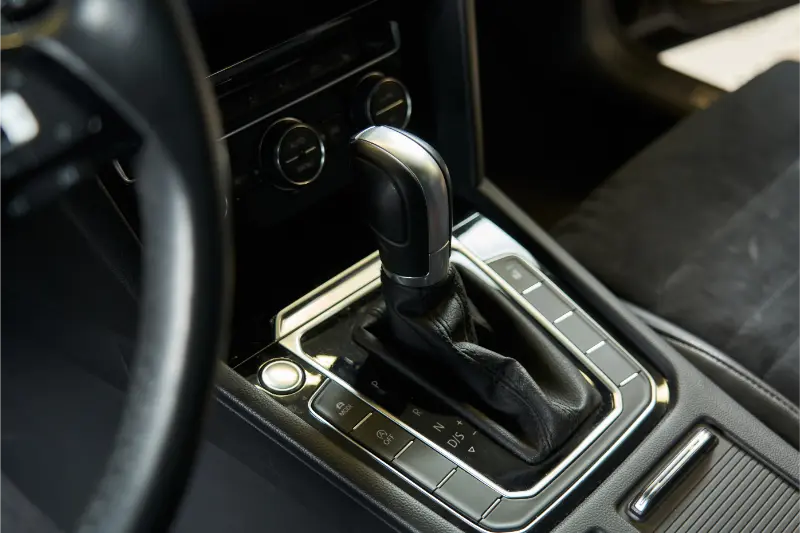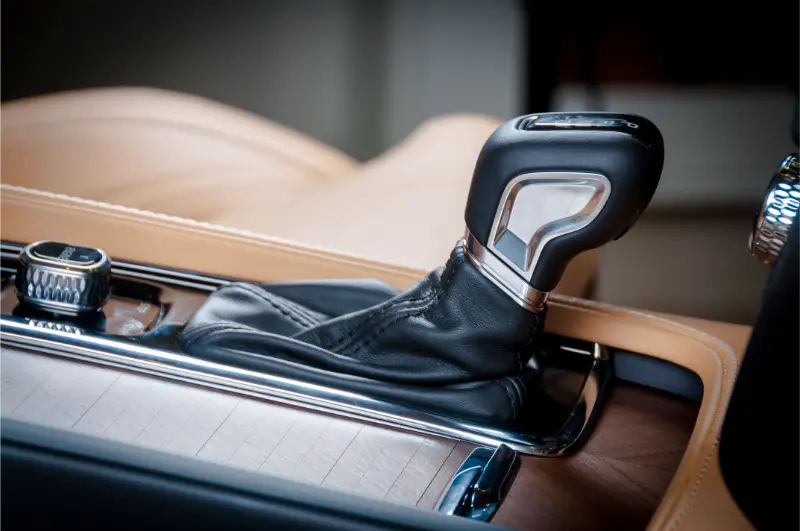If you’re wondering how to drive a DSG gearbox, it’s simpler than you might think. This guide will walk you through everything from starting the engine to mastering gear shifts, ensuring smooth, efficient control over your DSG-equipped vehicle. By the end of this article, you’ll be equipped with the knowledge to make your driving experience enjoyable and proficient without the technical jargon.
Key Takeaways
- DSG gearboxes offer automatic and manual transmission advantages, enabling quick, smooth gear shifts and improved fuel efficiency.
- Proper handling and maintenance of a DSG gearbox car are crucial for optimal performance. They require regular services every 40,000 miles and familiarity with features like the gear selector and paddle shifters.
- While DSG gearboxes are known for their reliability and efficiency, they can be more expensive to repair and may exhibit potential issues like hesitations or unusual noises.

Driving a DSG Gearbox: Step-by-Step Guide
Driving a car with a DSG gearbox is not just about getting to your destination; it’s about experiencing a unique blend of precision, control, and smoothness. In this step-by-step guide, we will go over how to get started with your DSG gearbox car, use the gear selector, and master braking and stopping. The DSG box offers significant advantages in stop-and-go traffic and hill starts, providing functionalities like ‘hill hold’ that enhance the driving experience.
Starting the Car
Starting a DSG-equipped car demands a bit of finesse. Here’s how to do it:
- Ensure that the gear is in ‘Park’.
- Firmly apply the foot brake.
- Press the start button.
- Wait for all warning lights to cycle before starting the engine.
In addition, DSG cars have a unique feature called “creep”. After the engine is started and ‘Drive’ is selected, the vehicle will move forward as soon as the foot is off the brake. This feature, commonly found in automatic cars, makes driving in slow traffic or waiting at traffic lights easier.
Using the Gear Selector
In a DSG car, the gear lever and the steering wheel are your trusted allies, allowing for smooth gear changes. The lever has options for:
- Park (P): Use this when your car is parked and stationary. It locks the transmission and prevents the car from rolling.
- Reverse (R): Engage this gear to move the car backwards. You can access Reverse by pushing the gear selector to the left from Drive (D) or Neutral (N), then upwards.
- Neutral (N): Use this when the car is stationary but the engine is running. For example, you might use Neutral while briefly waiting at a traffic light.
- Drive (D): This is the standard gear for forward driving. The car will automatically change gears as needed.
To transition from ‘Park ‘to ‘Drive’, depress the brake pedal, press the button on the gear lever, and slide the lever to the ‘D’ position. To reverse, push the gear lever to the left from ‘D ‘or ‘N’, then push it up. The ‘Neutral’ position is between ‘Drive’ and ‘Reverse ‘.
When you’re stopped, ‘Park’ locks the transmission and prevents the car from moving. Remember that using the gear selector properly and smoothly is important for a pleasant driving experience.
Braking and Stopping
Braking and stopping in a DSG car can require some practice. The key to mastering it is to use only one foot for the brake pedal and avoid using the clutch pedal. This is important as it prevents simultaneous engagement of the brake and accelerator, which can affect the power delivery in a DSG car.
When it’s time to stop, smoothly apply the brake pedal until you come to a complete stop. Afterwards, switch the gear selector to ‘P’, engage the handbrake, and release the brake pedal.
Remember to slow down in advance if you’re approaching a steep driveway. Gently crawl to the final stopping position for added safety and control.
How Do DSG Gearboxes Work?
DSG gearboxes are a type of automatic transmission that stands out due to their quick and smooth gear changes without interrupting power flow. Unlike traditional automatic gearboxes that use a torque converter, DSG gearboxes employ a dual-clutch system. This system allows for gears to be preemptively selected, contributing to their fast and responsive nature.
The dual-clutch system in a DSG gearbox works by having two separate clutches that facilitate quick and smooth gear changes without power interruption. This electronic control of the clutches prepares the next gear for seamless performance. Some key features of DSG gearboxes include:
- Quick and smooth gear changes
- No interruption of power flow
- Dual clutch system for preemptive gear selection
- Fast and responsive nature
The dual-clutch gearbox, also known as a DSG gearbox, has a unique design that minimizes jerkiness during gear shifts, allowing for a more efficient and seamless driving experience.
So whether it’s the DQ200 DSG used by the Volkswagen Group or any other DSG gearbox, you’re in for a seamless driving experience. With proper maintenance, newer DSG gearboxes are as reliable as other gearbox types and are a great option for drivers seeking ease while driving.
Advantages of DSG Gearboxes
DSG gearboxes, also known as dual-clutch gearboxes, offer several impressive advantages. The dual-clutch design of a DSG gearbox ensures practically seamless gear changes, as it pre-selects gears for instantaneous and precise shifting.
Moreover, DSG gearboxes are more fuel-efficient than traditional automatic transmissions. For example, the 7-speed DSG gearbox has improved fuel economy by up to 15%. This is because the twin-clutch design allows for quicker reaction times and better responsiveness.
DSG gearboxes combine the convenience of an automatic gearbox with the control and fun of a manual gearbox, making them an efficient and effective option compared to traditional manual car transmissions. Additionally, with the added benefit of manual mode, you can enjoy even more control over your driving experience.
Considerations of DSG Gearboxes
DSG (Direct Shift Gearbox) transmissions offer several advantages over traditional automatic transmissions, including faster gear changes and potentially improved fuel efficiency. However, there are also some factors to consider:
- Cost & Complexity: DSG gearboxes tend to be more expensive than traditional automatics due to their complex design. This complexity can also translate to potentially higher repair costs if problems arise.
- Driving Experience: DSG transmissions prioritise smooth and efficient gear changes, which can result in a less engaging driving experience for some who prefer more control.
- Potential Issues: Like any mechanical system, DSG gearboxes can experience issues over time. Some of the common problems that may arise include shifting problems such as hesitation, jerking or delayed gear changes, unusual vibrations or noises, and clutch wear.
While clutches in DSG gearboxes are designed to last, aggressive driving or excessive towing can accelerate wear. It is important to remember that not all DSG gearboxes will experience these issues, and proper maintenance can help extend their lifespan. Regular service intervals are crucial.
Mastering Manual Mode
Mastering manual mode in a DSG gearbox car can elevate your driving experience, offering a more engaging and responsive feel. Here’s how you can get started:
- Familiarize Yourself with the Gear Lever and Paddle Shifters: The gear lever is typically located on the centre console, while the paddle shifters are mounted on the steering wheel. Understanding how to use these controls is crucial for manual shifting.
- Start in a Safe Location: Find an empty parking lot or a quiet street to practice. This will allow you to get comfortable with manual mode without the pressure of traffic.
- Get Comfortable with the Gear Lever: Start practising shifts using the Gear Lever. Start from first gear and gradually move up to higher gears. This will help you understand the mechanics of shifting in a DSG gearbox car.
- Use the Paddle Shifters: Once you’re comfortable with the gear lever, use the paddle shifters. These allow for quick and smooth gear changes, enhancing your control over the vehicle.
- Practice in Different Driving Conditions: To master manual mode, practice in conditions such as uphill, downhill, and stop-and-go traffic. This will help you adapt to different scenarios and improve your driving skills.
- Use the Correct Gear for the Situation: Always select the appropriate gear for your driving conditions. For instance, use first gear when starting from a standstill and higher gear when driving at increased speeds.
- Avoid Riding the Clutch: Unlike a traditional manual gearbox, a DSG car has no clutch pedal. However, it’s still important to avoid unnecessary strain on the transmission by not riding the clutch.
- Use the Brake Pedal Correctly: Proper use of the brake pedal is essential, especially when shifting gears in manual mode. This is particularly important when driving downhill or in stop-and-go traffic.
Following these tips, you can master manual mode in your DSG gearbox car, making your driving experience more dynamic and enjoyable.
Popular Cars with DSG Gearboxes
DSG transmissions are not limited to a single manufacturer and can be found in various car brands. Some of the common carmakers offering models with DSG options include:
- Volkswagen Group (extensive use across various brands)
- Audi
- Škoda (Škoda uses the accented character š)
- SEAT
- Porsche (primarily used in higher-performance models)
- Ford (used in some Fiesta and Focus models in specific markets)
- Volvo (used in some older models, not as common currently)

Examples of Volkswagen Group Models with DSG
The Volkswagen Group, which includes Audi, Škoda, SEAT, and other brands, played a significant role in popularising DSG gearboxes. Here are some examples of Volkswagen Group models commonly equipped with DSG transmissions:
- Volkswagen: Golf GTI, Jetta GLI, Passat, Golf R, Scirocco, Eos, Beetle R-Line
- Audi: A3, TT, Q3 (in some markets)
- Škoda: Octavia, Superb
- SEAT: Leon, Ateca
It’s important to remember that DSG availability can vary depending on the specific model year, market region, and trim level.
DSG Gearbox Maintenance and Reliability
While early models from the 2000s experienced more issues, the newer DSG gearboxes are generally considered reliable. However, just like any other complex mechanical system, proper maintenance is crucial to ensure optimal performance and longevity. The intervals for servicing DSG gearboxes can vary, but they typically require maintenance at specific intervals. Aggressive driving or frequent towing can put extra strain on the DSG and necessitate more frequent maintenance.
A standard service interval for DSG gearboxes is typically around 40,000 miles, but it’s important to consult your vehicle’s manual for accurate information. While some DSG clutches might require replacement after 60,000 to 70,000 miles, there is no guaranteed timeframe. Following the manufacturer’s recommendations and maintaining a smooth driving style can significantly extend the lifespan of the clutch.
At Ivydene Garage Ltd., we offer the latest diagnostic and service equipment to effectively service DSG gearboxes. With over three decades of experience, you can trust us to keep your DSG gearbox car in top shape. Contact us for a quote today!
Troubleshooting Common Issues
Even though DSG gearboxes are known for their reliability, you might encounter some issues over time. Here are some common problems and troubleshooting tips to keep your DSG gearbox car running smoothly:
- Jerking or Lurching Forward: If your car jerks or lurches forward when you release the handbrake, it might be because the car’s computer mispredicts the correct gear. Try restarting the car and checking the transmission fluid level to ensure it’s adequate.
- Difficulty Shifting Gears: It can be frustrating to struggle to shift gears. This issue might stem from a faulty gear lever or paddle shifters. Clean these components and check for any blockages that might be causing the problem.
- Grinding or Whining Noises: Unusual noises when shifting gears could indicate worn-out clutch packs or gear teeth. Inspect these parts for wear and replace them if necessary to prevent further damage.
- Loss of Power: Experiencing a loss of power while driving can be alarming. This could be due to a faulty torque converter or issues with the gear lever. Check these components for any blockages or damage and address them promptly.
- Error Messages: If you see error messages on your dashboard, it might be due to a faulty transmission computer or sensor. Inspect these parts for faults and replace them if needed to restore proper function.
Following these troubleshooting tips, you can identify and resolve common issues with your DSG gearbox car, ensuring a smooth and responsive driving experience. Regular maintenance and prompt attention to problems will help keep your DSG gearbox in top condition.
Keep Your Car Running Smoothly: Expert DSG Gearbox Services at Ivydene Garage
At Ivydene Garage in Ashford, Kent, we offer expert services for your DSG gearbox to keep your vehicle in top condition. Our team of certified technicians has more than 32 years of experience in repairing gearboxes.
As a Bosch-recognized service centre, we ensure that our diagnostics and repairs meet the highest industry standards. We believe in transparency, so we keep you informed throughout the entire service process.
Don’t let transmission problems stop you from enjoying a smooth and efficient driving experience. Choose Ivydene Garage for all your DSG gearbox needs and experience the difference for yourself. Contact us today!
Tips for Driving a DSG Gearbox Car
DSG gearboxes offer a smooth and efficient driving experience. Here are some tips to get the most out of yours:
- Paddle Shifters: DSG cars often have paddle shifters on the steering wheel that allow manual gear changes. This can provide a more engaging driving experience when you want more control. However, remember that the DSG is designed for optimal performance in automatic mode, so manual shifting may not always be necessary.
- Hill Hold/Auto-Hold: This feature can be helpful for hill starts, as it prevents the car from rolling backwards when you take your foot off the brake.
- Drive Modes: Some DSG cars offer different drive modes, such as “Normal” and “Sport.” Sport mode might adjust engine and transmission behaviour for a more responsive feel, potentially beneficial for highway merging or overtaking. However, it can also decrease fuel efficiency.
Regardless of the driving mode, avoid sudden full-throttle starts, especially in wet or slippery conditions. This can help maintain traction and stability. Nevertheless, while DSG transmissions manage gear changes automatically, practising smooth control at low speeds, like reversing on slopes, can improve your overall driving experience.
DSG vs. Other Automatic Gearboxes
Traditional automatic gearboxes rely on a torque converter, whereas DSG gearboxes use a dual-clutch system to manage power transmission. This results in faster shift times and improved fuel efficiency, making DSG gearboxes a great option for those seeking optimal performance.
Frequently Asked Questions
What is a DSG gearbox?
A DSG gearbox, short for ‘direct shift gearbox’, is a type of automatic transmission that uses a dual-clutch system to enable seamless, quick gear changes without interrupting power flow.
How do I start a DSG-equipped car?
To start a DSG-equipped car, ensure the gear is in ‘Park’, apply the foot brake, and press the start button. This sequence is important for a smooth start.
What are some advantages of DSG gearboxes?
DSG gearboxes provide seamless gear changes, improved fuel economy, and better responsiveness thanks to their dual-clutch design.
How often should I service my DSG gearbox?
You should service your DSG gearbox every 40,000 miles, although the frequency may vary depending on your driving habits and other factors. Keeping up with regular servicing helps maintain the gearbox’s performance and longevity.
Can I manually change gears in a DSG gearbox car?
Yes, you can manually change gears in a DSG gearbox car using the paddle shifters for improved control and engagement.
Final Thoughts
DSG gearboxes offer a unique combination of precision, efficiency, and responsiveness that distinguishes them from traditional manual or automatic gearboxes. If you are starting to drive a DSG-equipped car, learning the art of braking, or exploring the many advantages of these gearboxes, it will be an exciting and enlightening journey. There’s nothing like firsthand experience to truly appreciate the magic of DSG gearboxes! For reliable and trustworthy DSG gearbox repairs and oil changes, choose Ivydene Garage. Contact us today to request a quote!
